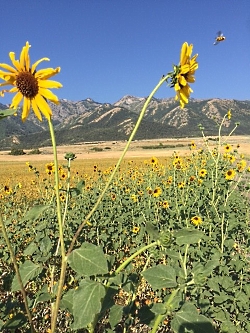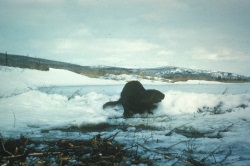
Courtesy & Copyright Mary Heers, Photographer
Wanting to know more, I dropped into the Honeyland store in Cache Valley and was soon mesmerized by the active cut-away hive on display. It was a teacher’s dream come true – hundreds of bees – all diligently on task. Wide-eyed, I watched as a bee flew in at the bottom of the screen through a tunnel under the window looking very much like a bike rider with two full paniers She deposited the full sacks of pollen and then she began to dance. This took me quickly to the internet to learn more.. The bees dance is called a “waggle dance” – a straight line calibrated to communicate how far away the food source is, and a circular return arc to orient the path to the food. The waggle dancing bee can direct her sisters to a food source up to five miles away.
I soon returned to the store’s cut away hive and finally found the queen – a bit tricky as she looks like all the others except she’s one and a half times bigger. I watched as she dipped her tail into one hexagonal cell after another. On a good day a queen will lay 2,000 eggs.
Busy, busy bees working together to set aside enough honey to feed themselves during the winter.
The poet Dick Paetzke once called honey “the soul of a field of flowers”
Mountain honey looks and tastes a little different than honey made by bees pollinating Cache Valley alfalfa. Both are incredibly delicious.
Aristotle got it right: “Honey is the nectar of the gods.”
This is Mary Heers and I am Wild About Utah.
Credits:
Photos: Courtesy & Copyright © Mary Heers
Text: Mary Heers
Additional Reading
https://thehoneybeeconservancy.org/
Burlew, Rusty, Honeybee Suite, https://honeybeesuite.com/
Honeybee, National Geographic Kids, https://www.nationalgeographic.com/animals/invertebrates/h/honeybee/
About The Honeybee, American Beekeeping Federation, https://www.abfnet.org/page/PollinatorFacts
Utah Beekeepers Association, https://www.utahbeekeepers.com/
Moab Bee Inspired Gardens, Utah State University, https://beeinspired.usu.edu/about/
Bee Fest 2020, Sponsored by Catalyst Magazine and Utah Museum of Natural History,
Recorded Facebook Livestream: https://www.facebook.com/events/2719162278365095/?post_id=2757236484557674&view=permalink
SLC Bee Fest Homepage: https://slcbeefest.com/?fbclid=IwAR3xJ4E-WMNm5hizCKiajsmu0brmG1kMKEwgS0IcWij0RwpjLYTdOu4bODs

